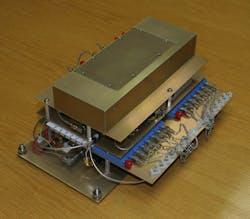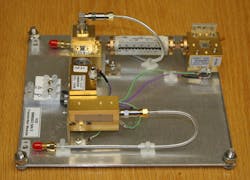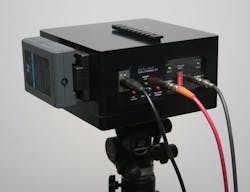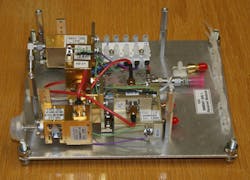Millimeter-wave frequencies offer wide usable wireless bandwidths in parts of the spectrum not normally used by electronic devices. Frequencies from 30 to 300 GHz represent a subset of the microwave frequency band, named for the sizes of these wavelengths, which range from one to ten millimeters. Because these millimeter-wave signals suffer high atmospheric losses, they are not suitable for long-distance transmissions. But they can support effective communications over distances to several kilometers using highly directional, “pencil” thin beams that also help prevent interference. Since these frequencies offer continuous bandwidth not available at more commonly used lower frequencies, millimeter-wave technology is an ideal solution for shorter-range, point-to-point, high-speed, high-bandwidth wireless applications.
Millimeter-wave technology, which is available in commercial transmitter/receiver units that can handle high-speed data rates at gigabit/s (Gb/s) transmission speeds, is used in various multi-billion-dollar markets, including cellular communications for next-generation microcell and picocell towers, for wireless trading on Wall Street, and for high-definition/three-dimensional (HD/3D) digital video for broadcasting and motion-picture industries. In addition, millimeter-wave technology has been reliably used for military communications applications for decades.
As the costs of millimeter-wave (MMW) integrated circuits (ICs) continue to decrease, the technology should see increasing use in commercial applications. Also, the promise of millimeter-wave technology has as much to do with the United States Federal Communications Commission (FCC) as any other factor. The FCC was formed by the Communications Act of 1934. As part of its mandate, the FCC allocates specific wavelength frequencies for everything from AM/FM radio stations to television, cellular telephones, satellite communications, aeronautics, and military applications—to name a few.
So far, many wireless applications have been crammed into narrow bandwidths at lower frequencies of the radio spectrum. The MMW bands offer available frequencies with wide bandwidths for analog and digital communications. These higher MMW frequencies provide bandwidths in support of applications that are hitting a “glass ceiling” at lower frequencies, that even refinements and improvements in wireless technology cannot overcome because of the limited bandwidths. Lower-frequency wireless allocations, for example, are typically 2 to 5 MHz in bandwidth. In the millimeter-wave spectrum, the total allocation potential is as much as 250 GHz, with 5, 7, 10, 15, and even 20 GHz of continuous bandwidth available. These millimeter-wave bands readily support practical data rates to 40 Gb/s and more.
Next-Generation Cellular
Millimeter-wave signals are highly directional in their propagation characteristics, making them well suited for cellular communications applications in crowded urban environments. In a market that analysts estimate will exceed $5 billion by 2015, the building of small base stations called microcells and picocells is expected to outnumber the installation of traditional cellular towers by a factor of as much as 20 to 1. Although these microcells and picocells cover smaller areas than traditional cellular stations, they require less power, with less cost, and occupy much smaller footprints than traditional “macro” cellular towers. This makes them ideal for installation in indoor locations such as entertainment venues, malls, airports, train stations, office buildings, and hotels.
This growing number of smaller cellular base stations is also creating a new backhaul connectivity problem: how to link these greater numbers of smaller cell sites, either through wired or wireless connections. In addition are concerns over frequency congestion and interference in dense cellular deployments where four or more picocells could be mounted on light poles in a single parking lot or on a rooftop.
An obvious solution for high-speed transmission of data-intensive content would be to establish a physical connection using fiber-optic cabling. However, the cost and challenge of implementing fiber-optic links to each microcell or picocell site is prohibitive, particularly in urban areas where streets and sidewalks cannot easily be trenched. As a result, outdoor “fiber-optic quality” wireless millimeter-wave products are currently being considered by providers. With typical link distances for picocell backhaul connections estimated at a few hundred meters between sites, and microcells at less than two kilometers, millimeter-wave transmission and reception products are ideally suited for such applications.
Wayne Pleasant is the former Chairman of the Wireless Communication Industry Association (WCIA) committee charged with helping the FCC establishes guidelines for the 80-GHz light licensed millimeter-wave band. He notes that “if you can’t run fiber optic cabling, millimeter wave wireless is the fastest, quickest, smallest and least expensive solution.” Pleasant notes that, “in many key ways, millimeter wave devices can be more reliable, and even faster, than fiber optics. Due to a reduction in latency, transmission speed is improved.” Millimeter-wave radios operate with small antennas in proportion to their small wavelengths, so that concerns for potential “visual pollution” caused when mounting a large quantity of such products to light poles, billboards, or sides of buildings are minimized.
Pleasant observes that “narrow beam antennas allow systems in these bands to be engineered in close proximity to one another without causing interference. Since a greater number of highly directive antennas can be placed in a given area, the net result is higher reuse of the spectrum, and higher density of potential users.”
In preparation for these expanding microcell and picocell requirements for millimeter-wave links, Renaissance Electronics and Communications (REC) and its wholly owned subsidiary, HXI, have developed a number of millimeter-wave radio products capable of high data rates. The firm has supported high-frequency component and subsystem military and commercial applications since 1991, with its GigaLink Light Speed radios the first millimeter-wave radios to achieve FCC certification for unlicensed and light licensed commercial applications in the 60- and 70-GHz millimeter-wave bands. With their generous available bandwidths at these frequencies, these radios support full-duplex communications throughputs of 1.25 Gb/s and higher. They are designed to minimize latency, or lags, in data transmission, which is critical to the next generation of data centric devices that must accommodate Voice over IP (VoIP), live digital streaming, large file downloads, and video conferencing through mobile handsets.
3D/HD Digital Video
Broadcast and video applications have sought ways to place HD digital video cameras in remote locations without wires or concern for interference. Both 3D filming and HD video have consumed available wireless bandwidth, pushing solutions higher in frequency towards millimeter-wave bands for these applications. Users in motion picture, television, sports, and Electronic News Gathering (ENG) organizations have looked for wireless methods of supporting these applications, with MMW frequencies offering the required bandwidths.
Because 3D is shot essentially utilizing two cameras that film slightly offset images that are synchronized to create the dimensional effect, two independent HD streams must be transmitted simultaneously. This immediately doubles the data transmission requirement and presents the challenge of doing so through a delivery system—physical or wireless—that has no latency issues. Fiber-optic cables used for digital 3D/HD applications have suffered latency problems that can affect the synchronization of the two digital streams of data. To compensate, complex and expensive multiplexers are needed, requiring racks of on-site equipment and a completely nonportable solution. Because of problems with fiber-optic cables, 3D/HD signals are often transferred by means of coaxial cables at distances to 300 m, although often with some sacrifice in resolution and signal quality.
Millimeter-wave frequency bands offer an alternative to fiber-optic and coaxial cables for transferring 3D/HD signals. For example, millimeter-wave radio links developed by Renaissance/HXI (the firm’s GigaLink HD links) transmit uncompressed raw HD/SDI video at 1.485 GB/s. Available in single- and dual-channel formats, the radio links transmit at distances to 500 m under clear-air conditions. They were developed for use with Sony HDC and HDCU-F950 Digital 4:4:4 CineAlta systems but can interface with any SMPTE 372M or SMPTE 292M compliant production system. Dual-channel versions of these millimeter-wave systems can transport independent video signals from two HD cameras or synchronized HD 3D signals at a combined rate of 2.970 Gb/s. The millimeter-wave systems operate without compression or forward error correction (FEC), to avoid the associated latency issues.
High-Frequency Trading
Millimeter-wave radios offer great promise for high-frequency-trading (HFT) applications, where trades must be executed quickly. These radios can speed connections between data centers and their markets. HFT grew from a Security & Exchange Commission (SEC) decision in 1998 to allow electronic exchanges to compete with the NYSE and other marketplaces. By 2010, HFT was accounting for more than 70% of the trades in US equity markets, and a growing percentage of trades in other countries. HFT is not based on large changes in stock prices but on analyzing large amounts of information to find opportunities for stock trading profits that may have been otherwise overlooked. Large profits can be made by executing millions of smaller transactions each day. HFT practices may involve holding stocks for mere seconds, and will start each day without any holdings.
HFT can produce profits based on small amounts per transaction, such as a quarter cent per share. According to Tabb Group, a financial markets research and strategic advisory firm, by 2008 traders earned $21 billion in profits from HFT. HFT is successful when teamed with the proper infrastructure, so that trading companies involved in HFT heavily invest in the hardware, software and personnel necessary to gather and analyze momentary changes in market data and then execute based on that data, and latencies must be minimized. Exchanges that have implemented systems for HFT have typically brought down the latency to about 3 ms on average.
Network communications latency is obviously a key concern for an application such as HFT. Contributors to network latency include the time it takes for a packet to travel between one place and another at the speed of light, the medium itself (optical fiber, wireless), and the size of the packet since larger packets take longer to receive and return than smaller ones. Latency can also be affected by the speed of processing through a router or other gateway node, and packets can experience storage and hard-disk access delays at intermediate devices such as switches and bridges.
Physical distances between communications points can affect latency. To reduce latency, trading firms have placed their computers as close as possible to those of the exchange. Of course, fear of terrorism attacks on the NY Stock Exchange have also caused many firms to move their data centers further from Manhattan, increasing the distances between HFT computers and trading systems and sometimes adding microseconds in latency to each round-trip signal transmission. But adding lines, such as fiber-optic cables, in a large city can cause problems, as Pleasant notes: “Running fiber often isn’t practical in an urban environment. To install fiber, you have to disrupt local infrastructure like digging up streets or hanging it on pre-existing structures, which is expensive and time consuming.”
Because of the difficulties in installing high-speed fiber-optic communications lines, many HFT companies are using wireless transmission systems to connect their data centers to the stock exchange. For a sufficiently short distance, a single millimeter-wave link can be used to make a direct connection. When distances are too great for a single link, a series of millimeter-wave links can be used to relay signals. The use of millimeter-wave technology can help an HFT firm to reduce latency in their connections versus fiber-optic links. As Pleasant points out: “Lower latency equals faster trading speeds which equals more money to be made for the end user. In this industry nanoseconds count, so having the lowest latency connections is a big deal.”
Renaissance Electronics and Communications, LLC, 12 Lancaster County Road, Harvard, MA 01451; (978) 772-7774.
About the Author
Jeff Elliott
Jeff Elliott is a Torrance, Calif.-based technical writer. He has researched and written about industrial technologies and issues for the past 15 years.




